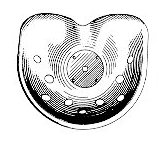HOW MANY HOLES?
| I have recently had inquiries about the number of holes that should be in the pan seats on the earlier tractors. They usually go something like THIS: | |
|
> Hi Meli... > I have a 1946 John Deere B with an aftermarket seat. I would like to replace it with the real thing. There is a seat on ebay that is supposedly the right seat, but it only has 3 round holes. My after market seat has about 9. I can't tell by looking at pictures if this is the right seat or not. I noticed on one of your overhead shots of one of your model b's that the seat only had three holes. Can you shed any light on this question.
> Thanks a bunch, > David | |
|
Hi Guys, I have a No. 58-R Repair Catalog that was issued on August 15, 1943, and the illustration of the seat shows NINE holes. It is essentially the SAME illustration that appears in the unstyled Model B parts catalog. BOTH catalogs list it as part number AD1606R. The style Model B parts catalog (PC-330) lists the same part number but does not show the number of holes. | |
| |
|  |
| HOWEVER, In an article about the early styled B in the July/August 1996 issue of Two-Cylinder Magazine it says "The AD1606R seat bucket was used on all styled B Tractors. The number of holes in the seat, however, reduced as time went on. From the start of the 1939 model year until an undetermined time in late 1941, there were nine holes. In 1942, 1943, and maybe all of the 1944 model year, there were seven holes. By 1945 and through part of 1946, there were five holes. By mid- to late 1946, it was down to three holes and stayed that way through the end of production in early 1947. The exact breaks when the number of holes changed is not precisely defined, as it appears that there were no exact breaks. Seat inventory during changeover periods probably included both the old and new versions, and they were installed-as-delivered to assembly." |
Go back to the page you just came from......
